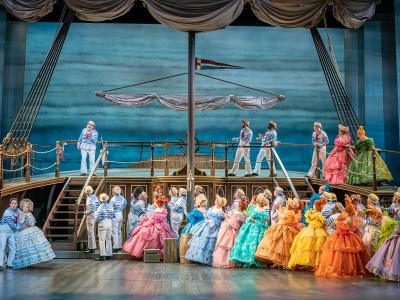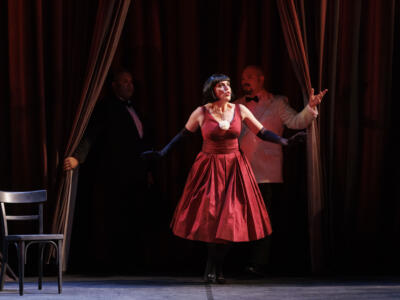Opera productions that were radical takes on seminal works
ENO launched its 2018/19 Season with a new production of Salome, Richard Strauss’s one-act opera based on Oscar Wilde’s celebrated play. It was the first production in a season of operas at the London Coliseum in which ENO explored and examined some of the patriarchal structures, relationships, and roles of masculinity within our society.
Adena Jacob’s production of Strauss’s Salome
Video
Composer-conductor Gustav Mahler hailed Salome as ‘one of the greatest masterpieces of our time’. Strauss himself regarded it as ‘a symphony in drama and, like all music, it has a psychological dimension.’
It is the inescapable psychological dimension to Salome that has caught the attention of Australian director Adena Jacobs, in collaboration with her designer Marg Horwell, to look afresh at this extraordinary piece of theatre.
Jacobs’s work is well-known for its refocusing of classical drama. She questions conventional patriarchal attitudes with results that are radical, contemporary and feminine. Her production undoubtedly challenges our accepted view of Strauss’s powerful masterpiece.
Richard Wagner’s staging of his operas at the Bayreuth Festival Theatre
Video
Like most aspects of opera in the last 150 years, Wagner’s influence has quite a lot to do with the changes in opera production. Not just Wagner the composer (who exerted an influence on Strauss and just about everyone else as well) but Wagner the opera director. He is the prototype of the modern opera director. His Bayreuth Festival Theatre, conceived to stage his Ring of the Nibelung and Parsifal, became a powerhouse of developments in dramaturgy.
His influence is very much apparent through the work of opera directors including Konstantin Stanislavsky, Vladimir Nemirovich-Danchenko, Max Reinhardt and, in the post-war era Wieland Wagner (the composer’s grandson), Walter Felsenstein in East Berlin and Ruth Berghaus. The approach to how to stage an opera can be just about as radical as there are operas to perform. Some directors favour the timeless relevance of universality in their readings. While figures such as Götz Friedrich, Patrice Chéreau (responsible for the 1976 centenary Bayreuth Ring) or Nikolaus Lehnhoff (his 1998 Parsifal for ENO) have been influenced by critical theories such as structuralism or post-structuralism. A questioning of hitherto perceived certainties is an important element in any radical operatic interpretation.
Jonathan Miller’s iconic productions of Verdi’s Rigoletto and Gilbert & Sullivan’s The Mikado
Video
Over the years ENO has been responsible for its fair share of innovative, often radical, productions. These have changed the way we think about an opera. One has only to consider two stalwarts of the company’s repertoire both directed by Jonathan Miller – Verdi’s Rigoletto and Gilbert & Sullivan’s The Mikado.
Looking at a work in a new way does not always necessitate a massive re-think of the composer’s original intentions. In fact by transposing Verdi’s Rigoletto from sixteenth-century Italy to 1950s New York, thereby making the womanising Duke of Mantua a mafia boss, ‘the Duke’, Miller was merely releasing an imposition made by the ever-vigilant censors on Verdi and finding an historically convincing parallel for our own times.
Read the Rigoletto introductory guide
Equally, his production of The Mikado rejects Gilbert & Sullivan’s original bijoux Japanese setting for an oh-so-English 1930s seaside hotel, with appropriately plummy vowels to match. Titipu becomes Bournemouth and was funnier for it.
Nicholas Hytner’s stylised staging of Handel’s Xerxes
Video
Both those Miller ENO productions date from the 1980s, and from the same decade one might add to the radical camp Nicholas Hytner’s stylised Xerxes. The production recreated the ancient Persian setting in the antiquarian spirit of Handel’s contemporaries.
Hytner’s version spearheaded a series of Handel productions at ENO and elsewhere that unleashed the psychological depth of these baroque masterpieces which had for so long been considered quite wrongly dramatically moribund.
ENO productions that were radical takes on seminal works
Video
Catalan director Calixto Bieito’s drug and sex-fuelled Don Giovanni was a disturbing contemporary vision of Mozart’s classic. The opening scene of his Masked Ball by Verdi with a row of toilets appears to have overshadowed the seriousness of the remainder of the production. But his Carmen positioned in the 1970s, his Spanish Civil War Force of Destiny and the universal humanity of his Fidelio all found him saying something personal about what it meant to be living in Spain under Franco’s regime.
German director Peter Konwitschny brought a very personal, even idiosyncratic, view of La traviata to ENO to mark the Verdi centenary year. He brutally cut the score which pared the opera down to the essentials of the drama, allowing it to play in a single, concentrated span of 100 minutes.
Australian-born director Barrie Kosky’s work at ENO in 2011 gave us his minimalist, contemporary approach to Rameau’s Castor and Pollux, complete with a massive slag heap of earth to represent the passage from earth to hell.
In her ENO debut, Adena Jacobs’s new Salome continues the company’s reputation for getting to the heart of the ideas and theatricality of the operatic repertory.




